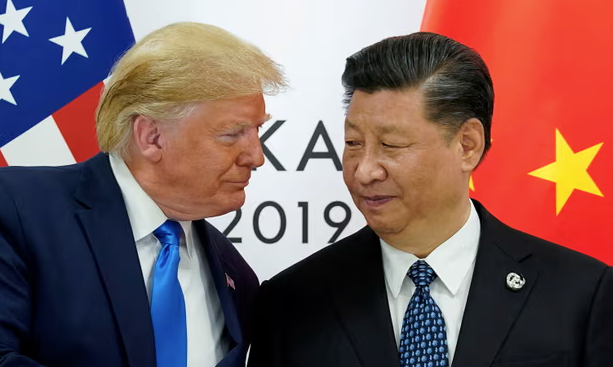Trump escalates trade war: U.S. to impose 104% tariffs on China amid global economic tensions

Key Points
- It seems likely that tariffs on Chinese imports will rise to at least 104% starting Wednesday, April 9, 2025, as announced by the White House.
- Research suggests this escalation follows China’s retaliatory tariffs and could lead to a broader trade war, impacting global markets.
- The evidence leans toward significant economic consequences, including potential layoffs and disruptions in industries reliant on US-China trade.
On Tuesday, April 8, 2025, at 11:37 AM PDT, the White House confirmed through Press Secretary Karoline Leavitt that President Donald Trump will impose an additional 50% tariff on Chinese imports, effective Wednesday, April 9, 2025.
This escalation brings the total tariff rate on some Chinese products to 104%, intensifying trade tensions between the US and China, the world’s two largest economies.
This note provides a comprehensive overview, incorporating recent developments and economic analyses, to understand the implications and context of this significant policy shift.
Tariff Escalation Details
The decision to raise tariffs to 104% follows China’s announcement of retaliatory 34% tariffs on all US goods, set to begin on April 10, 2025.
Initially, Trump had planned a 34% increase as part of his “reciprocal” tariffs package, but after Beijing did not back down by noon Tuesday, he added another 50%, resulting in the current 104% rate.
This build-up started with a 10% tariff imposed in February 2025, linked to allegations of China’s role in aiding illegal immigration and fentanyl trafficking into the US, which was doubled last month (Reuters).
China’s Commerce Ministry, earlier on Tuesday, firmly opposed the additional 50% tariffs, calling them “a mistake upon a mistake” and vowing to escalate retaliation against US exports, signaling a deepening trade conflict (Le Monde).
Market and Economic Impact
The announcement triggered immediate market reactions. US stocks, which had soared earlier Tuesday morning, began to decline following Leavitt’s comments.
By 2:30 p.m. ET, the Nasdaq and S&P 500 had entered negative territory, while the Dow remained slightly positive, reflecting investor anxiety over potential economic disruptions.
This volatility aligns with broader market fears, as seen in recent plunges, with the Dow dropping 2,231 points (5.5%), the S&P 500 down 5.97%, and the Nasdaq down 5.82%, entering bear market territory due to tariff-related uncertainties (CNN Live News).
Economically, the stakes are high. China was America’s second-largest source of imports in 2024, shipping $439 billion worth of goods to the US, while the US exported $144 billion to China.
The mutual tariffs threaten to hurt domestic industries, potentially resulting in layoffs, especially in sectors like technology, manufacturing, and agriculture, which rely heavily on cross-border supply chains (The Times of India).
White House Position and Broader Tariff Plans
Leavitt emphasized Trump’s resolve, stating, “Countries like China, who have chosen to retaliate and try to double down on their mistreatment of American workers, are making a mistake.
President Trump has a spine of steel, and he will not break.” She also noted China’s interest in a deal but uncertainty on how to proceed, declining to share specific terms for lowering tariffs (Yahoo Finance).
Beyond China, dozens of other countries and the European Union face a midnight deadline for new tariff rates, ranging from 11% to 50%, as outlined by Trump last week.
Despite conversations with world leaders aiming to negotiate lower rates, Leavitt indicated Trump has little appetite to delay, though he instructed his trade team to pursue “tailor-made” deals, with no fixed timeline provided (CNN Business).
Global and Economic Context
The tariff escalation is part of a broader strategy under the International Emergency Economic Powers Act (IEEPA), declared by Trump to address persistent trade deficits and protect American workers, potentially raising the average tariff rate on all imports to 16.5%—the highest since 1937—and shrinking US GDP by 0.4% (Fact Sheet).
Analysts, including JPMorgan, have raised the 2025 recession risk to 60% due to these policies, highlighting fears of a global trade war (CNBC).
China’s economy, aiming for 5% growth in 2025, may face challenges offsetting tariff impacts, potentially stimulating domestic demand, while US consumers could see price hikes, with examples like Apple potentially raising iPhone prices by 30% due to manufacturing reliance on China (CNBC).
Tariff Rates and Economic Indicators
| Category | Details |
|---|---|
| Trump’s Tariffs on China | Additional 50% tariff effective April 9, 2025, totaling 104% on some products. – Initial 10% in February 2025, doubled last month. – Retaliation from China: 34% tariffs on US goods from April 10, 2025. |
| Market Reactions | Dow plunged 2,231 points (5.5%), S&P 500 down 5.97%, Nasdaq down 5.82%, entering bear market. – Volatility post-announcement, Nasdaq and S&P 500 negative by 2:30 p.m. ET. |
| Economic Context | China: $439B imports to US in 2024, US exports $144B. – Potential layoffs, industry disruptions in tech, manufacturing, agriculture. |
| Broader Tariff Plans | Dozens of countries, EU face rates 11%-50%, midnight deadline April 8/9, 2025. – Negotiations ongoing, no fixed timeline for deals. |
As the deadline approaches, the likelihood of last-minute deals seems low, given both sides’ firm stances.
The tariff hike to 104% on Chinese imports, effective Wednesday, could mark a significant escalation in US-China trade relations, with potential ripple effects on global markets and economies.
Stakeholders, from governments to consumers, await further developments, hoping for a resolution that minimizes damage and restores stability.














